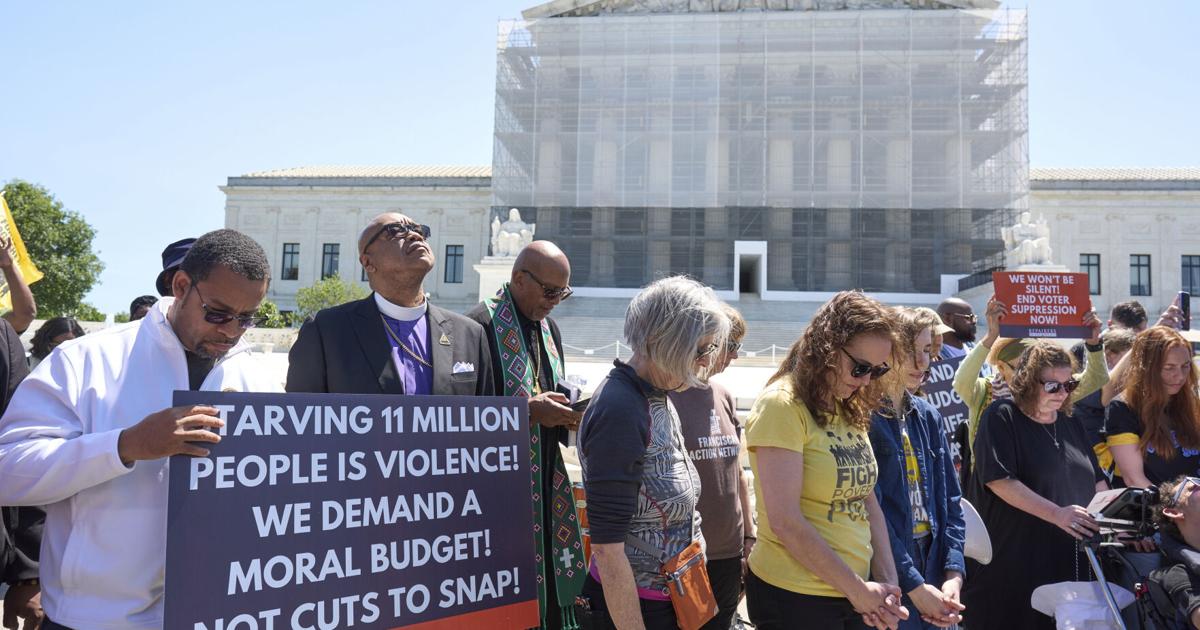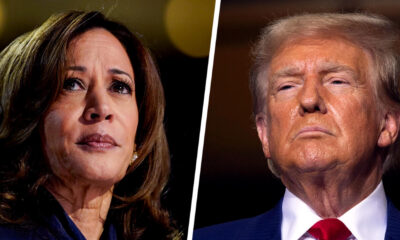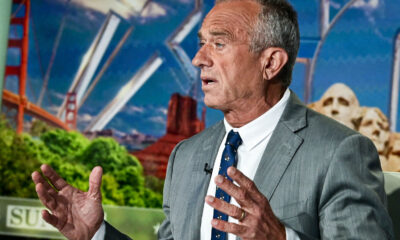The Dictatorship
States brace for impact as Trump’s big bill nears completion in Congress

JEFFERSON CITY, Mo. (AP) — President Donald Trump’s big bill to cut taxes and reduce federal spending on some social safety net programs could have large implications for states, but for many it’s too late to do much about it this year.
Tuesday marks the start of a new budget year in 46 states. Though some legislatures are still working, most already have adjourned and finalized their spending plans without knowing whether federal funding will be cut and, if so, by how much.
“The ebb and flow of rumors and reality have created great uncertainty and some anxiety in state governments,” said David Adkins, executive director of The Council of State Governments.
Several states have taken preemptive steps, setting aside money in reserves or tasking committees to monitor the impact of federal funding reductions. Others are tentatively planning to return in special sessions this year to account for potential funding cuts to joint federal-state programs such as Medicaid and the Supplemental Nutrition Assistance Program, or SNAP. Others will have to wait until their legislatures are back in session next year.
What’s at stake for states?
“If there are significant cuts, states wouldn’t be able to fully absorb those,” said Brian Sigritz, director of state fiscal studies at the National Association of State Budget Officers.
Nationally, the Medicaid health care program for lower-income residents accounts for 30% of total state expenditures, according to the health policy research organization KFF. That makes it the costliest program in many states, ahead of even K-12 education. The bulk of Medicaid money comes from the federal government, meaning any changes in federal policy can create big ripples for states.
Legislation pending in Congress would affect Medicaid in several ways. New work requirements are expected to reduce enrollment by millions of people, while other proposed changes also could reduce federal payments to states.
Until now the federal government also has covered the full cost of SNAP benefits and half the administrative costs. Trump’s bill would shift more of those costs to states, leaving them to either divert money from other purposes or trim back their food assistance programs.
The Medicaid and SNAP changes are just the latest in a series of Trump policies affecting state finances, including the rollback of grants for transportation and high-speed internet projects and attempts to withhold federal funds from sanctuary jurisdictions that limit cooperation with federal immigration authorities.
Some legislatures are stocking up on savings
A surge in federal aid and state tax revenue during the coronavirus pandemic led to booming budgets and historic cash surpluses in many states. As revenues slow and those surpluses get spent, some states now are trying to guard against federal funding reductions.
New Mexico enacted a law this year creating a Medicaid trust fund gradually stocked with up to $2 billion that can be tapped to prop up the program if federal funding cuts would otherwise cause a reduction in coverage or benefits.
Hawaii lawmakers, in crafting the state’s budget, left an extra $200 million in the general fund as a contingency against federal funding uncertainty. They plan to return for a special session.
And Vermont’s budget sets aside up to $110 million in case federal funding is cut. That includes $50 million that can be spent while the Legislature is not in session and up to $60 million that could be appropriated in the future to address federal funding shortfalls.
Though not necessarily tied to federal cuts, Florida lawmakers approved a proposed constitutional amendment that would set aside $750 million a year — or an amount equal to up to 25% of the state’s general revenue, whichever is less — in a reserve fund that lawmakers could use for emergencies. That measure still must go before voters.
Some governors are cutting back on spending
Because of legislative deadlines, some state lawmakers had to craft budgets well before the details of Trump’s bill took shape.
Virginia lawmakers passed a budget in February for their fiscal year that starts Tuesday. Republican Gov. Glenn Youngkin announced several dozen line-item vetoes in May with the goal of creating a roughly $900 million financial cushion.
“There are some short-term risks as President Trump resets both fiscal spending in Washington and trade policies that require us to be prudent and not spend all of the projected surplus before we bank it,” Youngkin said in a statement.
Republican Missouri Gov. Mike Kehoe on Monday vetoed or froze about $500 million of general fund budget items, citing a need “to rein in unsustainable spending” and guard against a projected future shortfall.
Other states also have left money unspent, even though it has not always been touted as a buffer against federal cuts.
States are “enacting really cautious budgets, knowing that they may have to kind of revise them in special sessions or address changes in next year’s sessions,” said Erica MacKellar, a fiscal affairs program principal at the National Conference of State Legislatures.
Some are taking a wait-and-see approach
Before adjourning their sessions, some state legislatures established procedures to monitor federal funding cuts and recommend budgetary changes.
Montana’s budget includes $50,000 for an analysis of the financial implications of federal actions, but that spending kicks in only upon the cancellation of at least $50 million of previously approved federal funding or the anticipated loss of at least $100 million of future revenue.
If federal funding to Maryland decreases by at least $1 billion, a provision approved by lawmakers requires the state budget office to submit a report to the General Assembly with proposed actions and potential spending reductions.
The spending plan passed by Connecticut lawmakers also requires the state budget office to respond quickly to federal reductions by identifying state funds that could be used to preserve programs, particularly those providing health care, food assistance, education and other priorities.
North Dakota lawmakers left room for more work. They adjourned their biennial session six days shy of their 80-day limit, allowing time to reconvene if needed.
The Dictatorship
Hamas is open to a ceasefire agreement. But Netanyahu says there’s no room for group in postwar Gaza

CAIRO (AP) — Hamas and Israel staked out their positions Wednesday ahead of expected talks on a Washington-backed ceasefire proposal, with the militant group suggesting it was open to an agreement while the Israeli prime minister vowed that “there will be no Hamas” in postwar Gaza.
Both sides stopped short of accepting the proposal announced Tuesday by U.S. President Donald Trump. Hamas insisted on its longstanding position that any deal bring an end to the war in Gaza.
Trump said Israel had agreed on terms for a 60-day ceasefire in Gaza and urged Hamas to accept the deal before conditions worsen. The U.S. leader has been increasing pressure on the Israeli government and Hamas to broker a ceasefire and hostage agreement.
Trump said the 60-day period would be used to work toward ending the war — something Israel says it won’t accept until Hamas is defeated. He said a deal might come together as soon as next week.
But Hamas’ response, which emphasized its demand that the war end, raised questions about whether the latest offer could materialize into an actual pause in fighting.
Hamas official Taher al-Nunu said the militant group was “ready and serious regarding reaching an agreement.” He said Hamas was “ready to accept any initiative that clearly leads to the complete end to the war.”
A Hamas delegation was expected to meet Wednesday with Egyptian and Qatari mediators in Cairo to discuss the proposal, according to an Egyptian official. The official spoke on condition of anonymity, because he wasn’t authorized to discuss the talks with the media.
Smoke from Israeli bombardment billows over the Gaza Strip, seen from southern Israel, Tuesday, July 1, 2025. (AP Photo/Ariel Schalit)
Smoke from Israeli bombardment billows over the Gaza Strip, seen from southern Israel, Tuesday, July 1, 2025. (AP Photo/Ariel Schalit)
Disagreement on how the war should end
Throughout the nearly 21-month-long war, ceasefire talks between Israel and Hamas have repeatedly faltered over whether the war should end as part of any deal.
Hamas said in a brief statement Wednesday that it had received a proposal from the mediators and was holding talks with them to “bridge gaps” to return to the negotiating table.
Hamas has said it’s willing to free the remaining 50 hostages, less than half of whom are said to be alive, in exchange for a complete Israeli withdrawal from Gaza and an end to the war.
Israel says it will only agree to end the war if Hamas surrenders, disarms and exiles itself, something the group refuses to do.
“I am announcing to you — there will be no Hamas,” Israeli Prime Minister Benjamin Netanyahu said during a speech Wednesday.
An Israeli official said the latest proposal calls for a 60-day deal that would include a partial Israeli withdrawal from Gaza and a surge in humanitarian aid to the territory. The mediators and the U.S. would provide assurances about talks to end the war, but Israel isn’t committing to that as part of the latest proposal, the official said.
The official wasn’t authorized to discuss the details of the proposed deal with the media and spoke on condition of anonymity.
It wasn’t clear how many hostages would be freed as part of the agreement, but previous proposals have called for the release of about 10.
“I’m holding my hands and praying that this will come about,” said Idit Ohel, mother of Israeli hostage Alon Ohel. “I hope the world will help this happen, will put pressure on whoever they need to, so the war will stop and the hostages will return.”
On Monday, Trump is set to host Netanyahu at the White House, days after Ron Dermer, a senior Netanyahu adviser, held discussions with top U.S. officials about Gaza, Iran and other matters.
Mourners attend the funeral of members of Al-Aimawi family who were killed in an Israeli bombardment of Al-Zawaideh, at Al-Aqsa Hospital morgue in Deir al-Balah, Gaza Strip, on Tuesday, July 1, 2025. (AP Photo/Abdel Kareem Hana)
Kidney patients sit amid the destruction caused by the Israeli army at Shifa Hospital compound in Gaza City on Tuesday, July 1, 2025, as they wait to leave after the facility suspended its dialysis unit services due to fuel shortages needed to power its generators. (AP Photo/Jehad Alshrafi)
Trump issues another warning
On Tuesday, Trump wrote on social media that Israel had “agreed to the necessary conditions to finalize” the 60-day ceasefire, “during which time we will work with all parties to end the War.”
“I hope, for the good of the Middle East, that Hamas takes this Deal, because it will not get better — IT WILL ONLY GET WORSE,” he said.
Trump’s warning may find a skeptical audience with Hamas. Even before the expiration of the war’s longest ceasefire in March, Trump had repeatedly issued dramatic ultimatums to pressure Hamas to agree to longer pauses in the fighting that would see the release of more hostages and a return of more aid for Gaza’s civilians.
Still, Trump views the current moment as a potential turning point in the brutal conflict that has left more than 57,000 dead in the Palestinian territory.
Gaza’s Health Ministry said the death toll passed the 57,000 mark Tuesday into Wednesday, after hospitals received 142 bodies overnight. The ministry does not differentiate between civilians and combatants in its death count, but says that more than half of the dead are women and children.
Since dawn Wednesday, Israeli strikes killed a total of 40 people across the Gaza Strip, the ministry said. Hospital officials said four children and seven women were among the dead.
The Israeli military, which blames Hamas for the civilian casualties because it operates from populated areas, was looking into the reports.
The war began on Oct. 7, 2023, when Hamas-led militants attacked southern Israel, killing 1,200 people and taking roughly 250 hostages.
The fighting has left the coastal Palestinian territory in ruins, with much of the urban landscape flattened in the fighting. More than 90% of Gaza’s 2.3 million population has been displaced, often multiple times. And the war has sparked a humanitarian crisis in Gaza, pushing hundreds of thousands of people toward hunger.
The sun sets over damaged buildings in the Gaza Strip, seen from southern Israel, Tuesday, July 1, 2025. (AP Photo/Ariel Schalit)
The sun sets over damaged buildings in the Gaza Strip, seen from southern Israel, Tuesday, July 1, 2025. (AP Photo/Ariel Schalit)
Hospital director killed
The director of the Indonesian Hospital, Dr. Marwan Al-Sultan, was killed in an apartment in an Israeli strike west of Gaza City, a hospital statement said. The hospital is the Palestinian enclave’s largest medical facility north of Gaza City and has been a critical lifeline since the start of the war.
The hospital was surrounded by Israeli troops last month and evacuated alongside the other two primary hospitals in northern Gaza.
The bodies of the doctor, his wife, daughter and son-in-law, arrived at Shifa Hospital torn into pieces, according to Issam Nabhan, head of the nursing department at the Indonesian Hospital.
“Gaza lost a great man and doctor,” Nabhan said. “He never left the hospital one moment since the war began and urged us to stay and provide humanitarian assistance. We don’t know what he did to deserve getting killed.”
In central Gaza, the Al Awda Hospital said an Israeli strike near the entrance of a school housing displaced Palestinians killed eight people, including three children, and wounded 30 others. The hospital also said Israel struck a group of Palestinians who gathered near the entrance of the hospital’s administration building in Nuseirat refugee camp.
In other developments, Israel said an airstrike last week killed two Hamas members who allegedly took part in a June 24 attack in which seven Israeli soldiers were killed when a Palestinian attacker attached a bomb to their armored vehicle.
___
Bassem Mroue reported from Beirut. Moshe Edri in Tel Aviv, Israel, Kareem Chehayeb in Beirut, and Josef Federman in Jerusalem, contributed to this report.
___
Follow the AP’s war coverage at https://apnews.com/hub/israel-hamas-war
The Dictatorship
Zohran Mamdani’s modest grocery proposal has sparked a right-wing panic for no reason

The Democratic nominee for mayor in New York City Zohran Mamdanihas commanded a share of the nation’s attention that few candidates for local office will ever achieve. Many of the controversies swirling around him have at least centered on issues that always inspire heated debate, like the Israeli/Palestinian conflict. Since his victory in the primary, though, a surprising number of denunciations of Mamdani by conservatives and libertarians have centered around … grocery stores.
Writing in The Wall Street Journal, John Catsimatidis (who owns the grocery store chains Gristedes and D’Agostino’s) warned that Mamdani’s policies on grocery sales amount to “radical socialism” and, if implemented, “would collapse our food supply, kill private industry, and drag us down a path toward the bread lines of the old Soviet Union.” The same analogy was pursued by Megan McArdle in The Washington Post. “Forget the old-school communist talk about socializing the means of production,” McCardle wrote. “Mamdani wants to socialize the means of consumption.”
A surprising number of denunciations of Mamdani by conservatives and libertarians have centered around … grocery stores.
Judging by these reactions, you’d think that Mamdani had, at the very least, proposed expropriating every privately owned supermarket and bodega in the city and placing them under control of a People’s Commissariat of Food Supply. You might even wonder if he’d gone further and proposed sending the NYPD to conquer some rural areas of upstate New York and forcibly collectivize agriculture there.
In reality, he’s proposed a very modest experiment. He doesn’t want to touch a single privately owned store. Instead, he wants to start five new city-owned grocery stores, one in each of the five boroughs, designed to provide a public option for grocery shopping in the areas within those boroughs with the fewest private options (where grocery prices at those few stores that do operate tend to be very high).
If this sounds like an extreme proposal, it shouldn’t. There are 17 states around the country with public monopolies on liquor stores. One of these is the most otherwise libertarian state in the union, New Hampshire, whose state motto is “Live Free or Die.” If the 80 state-owned liquor stores in New Hampshire don’t inspire hysterical analogies to the Soviet Union, despite the lack of private competitors, introducing a grand total of five private groceries to New York City (whose population is almost eight times the total population of New Hampshire) shouldn’t either.
Billy Binion, a writer for the libertarian magazine Reason, argues that this is an analogy that should make us more skeptical of the idea, rather than less. After the end of Prohibition, he points out, some politicians in these states supported moving state monopolies on liquor stores because they “wanted drinking to be difficult and expensive after alcohol was legalized again.” As such, the analogy to food sales “isn’t exactly reassuring.”
But there’s a world of difference between why some prohibitionist dead-enders might have supported a policy in the 1930s and why it remains popular in the 2020s.
The difference between prevailing attitudes in different states also matters. Are we really supposed to believe that voters and politicians in “Live Free or Die” New Hampshire continue to support the state monopoly because they wish Prohibition would come back and, failing that, they want a nanny state to do everything it can to discourage drinking?
If so, the policy has been a truly spectacular failure. States are clustered together closely in that part of the country, and people from around the region often drive to New Hampshire for the sole purpose of stocking up on cheap liquor at the state liquor stores. Anyone who’s ever driven into the state will remember the giant billboards directing people to those stores. In fact, NPR reported several years ago that latter-day bootleggers are sometimes caught buying up hundreds of bottles of cheap New Hampshire liquor to resell in other states. Far from being a hotbed of neo-prohibitionism, New Hampshire keeps its liquor store policy in place precisely because it brings much-needed revenue to a state that’s notoriously reluctant to raise funds through taxation.
It’s a quirk of culture and history that publicly owned liquor stores are so much more common in capitalist countries than publicly owned stores selling milk and eggs, but on a basic logistical level, a city-owned grocery store in Queens would be much more like a state-owned liquor store in New Hampshire than it would be like a Soviet grocery store. Aside from John Catsimatidis and Megan McCardle, I’ve never heard anyone suggest that the reason shelves were so often empty at Soviet stores was because the stores themselves didn’t know how to order needed goods from suppliers or stock the shelves, rather than the problems with making sure the actual production of goods was coordinated with fine-grained consumer preferences in a system where every aspect of the economy was centrally planned.
Perhaps, given the smaller profit margins in stores selling perishable groceries than stores selling beer, wine and hard liquor, though, Mamdani’s proposed experiment with a tiny number of municipal grocery stores would be a failure and it would have to be abandoned. There’s no way to be certain before it’s tried.
New Hampshire keeps its liquor store policy because it brings much-needed revenue to a state that’s notoriously reluctant to raise funds through taxation.
What I can’t get over, though, is the massive contradiction at the heart of the right-wing panic about his proposal. If the shelves would be empty since no public employee could ever navigate the delicate logistical hurdles, why on earth would anyone shop there rather than finding a private alternative? But if so, how are we supposed to understand the claim in the Wall Street Journal op-ed that Mamdani wants to “replace” private with public grocery stores? Is the problem that any city-owned grocery stores would be horrendously inefficient, such that we’d see empty shelves to the Leningrad in 1970? Or is it that they’ll be so wildly successful that the initial experiment with five stores will mushroom and all private competitors will eventually be put out of business?
Neither criticism is especially compelling on its own. But if critics want to make any sense at all, they have to pick.
Ben Burgis is a political commentator and author. He has written articles for Jacobin and The Daily Beast.
The Dictatorship
The lie Republicans will use to sell punishing megabill cuts to MAGA voters

When President Ronald Reagan was trying to justify massive cuts on social programs, he would often invoke the so-called welfare queen.
His rhetoric focused on an imaginary American — typically assumed to be a Black, single woman — who was living large on the public dole.
Today’s Republicans haven’t invoked the stereotype as they’ve set about slashing the safety netbut that may be because they don’t have to.
There’s a persistent myth in American politics that poverty has a single face and that face is usually Black, often female, and somehow responsible for her own hardship.
The Senate voted to pass the “big, beautiful bill” on Tuesday. The House, after wavering for a few hours on Wednesday nightis now poised to send it to President Donald Trump’s desk in time for his Fourth of July deadline. But even as Trump and his allies in Congress have prepared to take food off the tables of poor Americans with their megabillthe decades-long project to demonize social welfare programs has helped them avoid accountability.
And make no mistake, the people that many of these cuts are going to hurt the most are the white, rural voters who backed Trump in the last three elections.
There’s a persistent myth in American politics that poverty has a single face and that face is usually Black, often female, and somehow responsible for her own hardship.
That myth was not born by accident. It was crafted, polished and weaponized. It was built on decades of policy choices and political messaging that added racial overtones to programs designed to combat poverty among all Americans in an effort to erode public support.
Ironically, these programs began as ways to help poor white people. When the New Deal began tackling poverty, programs such as Aid to Dependent Children (later renamed Aid to Families with Dependent Children, AFDC) were designed to support mostly white, widowed mothers suffering in the Great Depression.
It wasn’t until the Civil Rights Movement gained traction in the 1960s that more Black families became able to access these same benefits. That led to a backlash against them that the right has long used to try to undercut them.
By the 1970s, amid rising inflation, economic anxiety and racial resentment, conservatives began to cast what was known as “welfare” not as a ladder out of poverty but as a trap and its recipients as ungrateful, unproductive burdens on the system.
Reagan took a story about a real woman convicted of fraud and exaggerated it into the fictional ‘welfare queen.’
That set the stage for Reagan, who took a story about a real woman convicted of fraud and exaggerated it into the fictional “welfare queen” who was supposedly cashing multiple checks under multiple names and driving a Cadillac.
The strategy worked. The “welfare queen” myth gave policymakers from both parties permission to strip benefits from millions of people.
When President Bill Clinton signed the 1996 welfare reform bill, officially ending AFDC and replacing it with Temporary Assistance for Needy Familiesthe damage was codified. Clinton promised to “end welfare as we know it,” and he did. But what also ended was any real commitment to a guaranteed safety net in this country.
The truth is, the majority of people living in poverty in America today are not Black. They are white, rural Americans, children and veterans. They are seniors on fixed incomes or single mothers juggling multiple jobs and still coming up short. The face of poverty is not who many Americans have been conditioned to see.
The cost of that conditioning is showing up in real time.
Last month, House Republicans advanced a tax bill that would give about $4 trillion in permanent tax breaks to the wealthy and big corporations over the next 10 years. And earlier this week, the Senate passed a revised version of that bill that would lock in those tax cuts that overwhelmingly help the rich. How do they plan to pay for it? By targeting the very programs that keep working people afloat — like SNAP and Medicaid. This isn’t fiscal responsibility. It’s cruelty disguised as economics.
Democratic Rep. Brendan Boyle of Pennsylvania joined us on “The Weeknight” earlier this week to make this very point. He reminded viewers that there are two counties in Pennsylvania that are directly tied for the highest poverty rate. One is in Philadelphia and the other is Fayette County, which is along the border of West Virginia and 95% white. That truth rarely gets its deserved airtime, yet it is central to the stakes of this moment.
Vague political language like “spending cuts,” “entitlement reform” and “deficit reduction” allow harmful assumptions to do the dirty work.
Vague political language like “spending cuts,” “entitlement reform” and “deficit reduction” allow harmful assumptions to do the dirty work. It keeps people from realizing that when Congress cuts SNAP, they’re not punishing a stereotype. They’re punishing real people. The single mother in Appalachia. The retiree in Arizona. The family in Detroit living paycheck to paycheck.
Many of them are Trump voters, including both his die-hard supporters and those who say they were fed up with inflation and looking for change last November.
They will soon suffer from these cuts, too. So why did they vote against their own interests? Because they’ve been sold a story, one that says that the “takers” are Black and brown and implicitly promises that the pain will be inflicted on someone else. One that allows some people in poverty to think that they’re the virtuous ones who are being held back and that the cuts will only affect the “waste, fraud and abuse” coming from somewhere else.
The truth will become clear soon enough. Some of these voters may come to realize they’ve been sold a bill of goods. Let’s hope that the horrific effects of this legislation eventually cause a moment of reckoning for the people who continue to try to sell the lie of the “welfare queen” to justify their own cruelty.
For more thought-provoking insights from Michael Steele, Alicia Menendez and Symone Sanders-Townsend, watch “The Weeknight” every Monday-Friday at 7 p.m. ET on BLN.

Symone D. Sanders Townsend is an author and a co-host of “The Weeknight,” which airs Monday through Friday at 7 p.m. ET on BLN. She is a former deputy assistant to President Joe Biden and a former senior adviser to and chief spokesperson for Vice President Kamala Harris.
-

 The Josh Fourrier Show8 months ago
The Josh Fourrier Show8 months agoDOOMSDAY: Trump won, now what?
-
Uncategorized8 months ago
Bob Good to step down as Freedom Caucus chair this week
-

 Politics8 months ago
Politics8 months agoWhat 7 political experts will be watching at Tuesday’s debate
-

 Politics8 months ago
Politics8 months agoHow Republicans could foil Harris’ Supreme Court plans if she’s elected
-
Economy8 months ago
Fed moves to protect weakening job market with bold rate cut
-
Economy8 months ago
It’s still the economy: What TV ads tell us about each campaign’s closing message
-

 Politics8 months ago
Politics8 months agoRFK Jr.’s bid to take himself off swing state ballots may scramble mail-in voting
-
Uncategorized8 months ago
Johnson plans to bring House GOP short-term spending measure to House floor Wednesday







